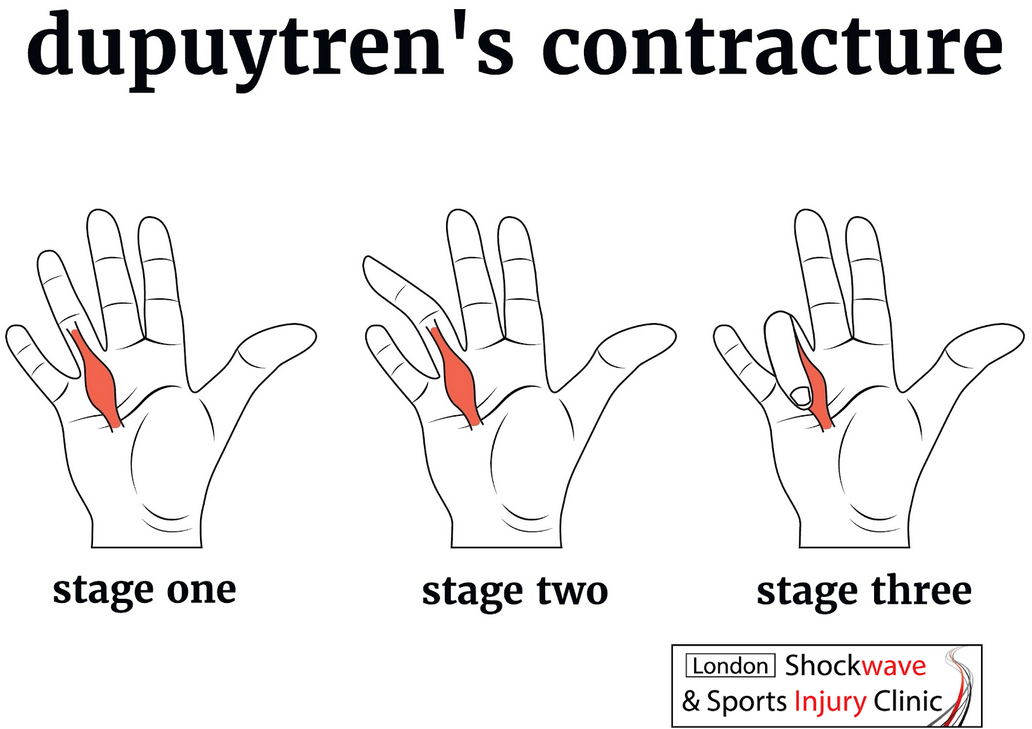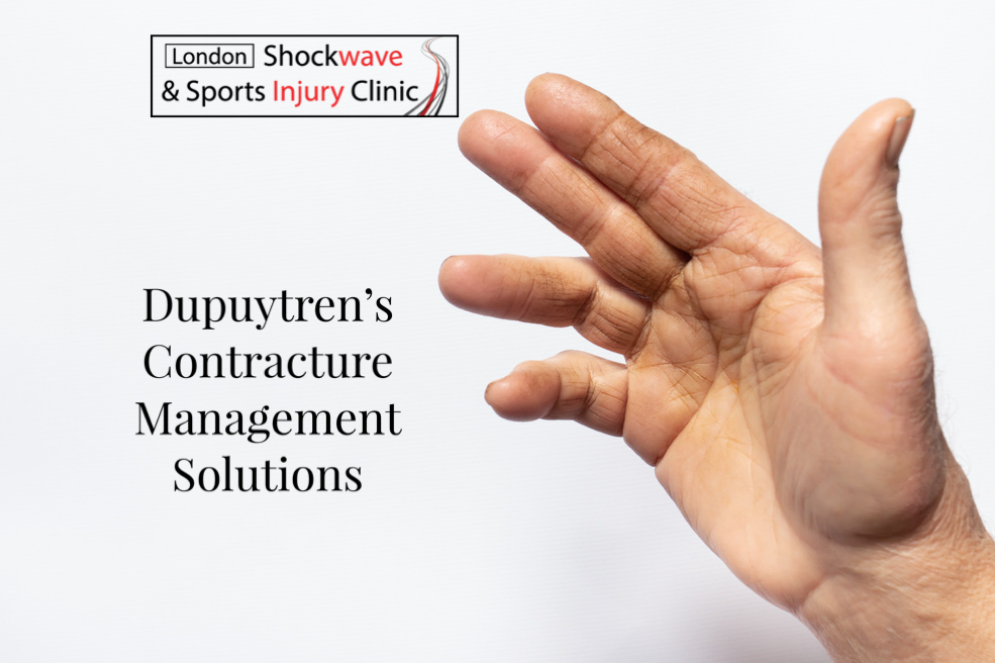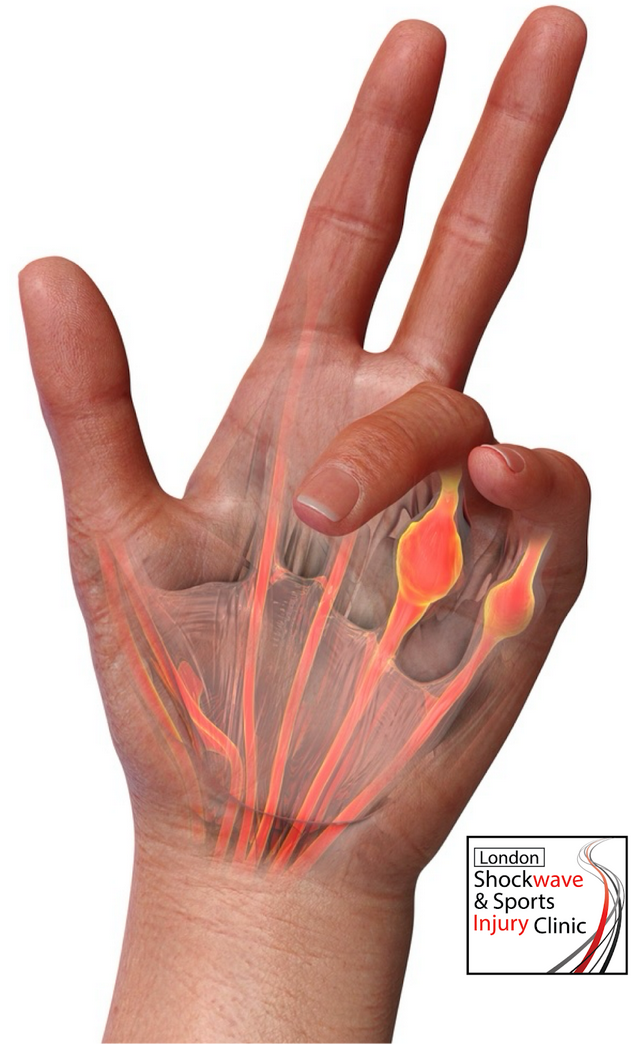Dupuytren's contracture Treatment with shock wave therapy in Wimbledon London

Dupuytren's contracture is a hand condition that gradually causes the fingers to bend towards the palm, restricting their movement. This condition arises from the thickening and shortening of the palmar fascia, the connective tissue under the skin of the palm. Although the exact cause of Dupuytren's contracture remains unknown, it is believed to be that it involve a combination of genetic and environmental factors.
This article delves into the nuances of Dupuytren's contracture, including its subtypes or grades, demographic impact, potential triggers, treatment options, and the promising role of Focused shock wave therapy (f-est) in managing early-stage stage disease.
Dupuytren's Contracture the Demographics and Triggers
Dupuytren's contracture predominantly affects individuals of Northern European (Scandinavian, Scottish, Irish) or Icelandic descent, suggesting a genetic predisposition. Men are more frequently affected than women, and the condition is rare before the age of 40, with the prevalence increasing with age. Several factors can trigger or exacerbate the condition, including smoking, alcohol consumption, diabetes, and epilepsy. There is also a correlation between manual labour or hand trauma and the onset or progression of Dupuytren's contracture, although the relationship is not fully understood.
Dupuytren's contracture Subtypes or Grades
Dupuytren's contracture is categorised into several grades, reflecting the severity of the condition:
Grade 1: Involves the presence of nodules and cords in the palm without affecting finger movement.
Grade 2: The fingers begin to bend towards the palm, but the contracture is less than 30 degrees.
Grade 3: More significant bending of the fingers (31 to 60 degrees), affecting hand function.
Grade 4: Severe contracture (more than 61 degrees), with the fingers being pulled towards the palm, significantly impairing hand function.
These grades help in determining the most appropriate treatment approach.
Treatment Choices for Dupuytren's Contracture

Treatment for Dupuytren's contracture aims to improve hand function and may vary based on the disease's severity and progression rate. Options include:
- Observation: For mild cases without significant impairment.
- Needle Aponeurotomy: A minimally invasive procedure to break the cord causing finger contracture.
- Collagenase Injections (Xiaflex): Enzymes injected to dissolve the cord tissue.
- Surgery: Reserved for more advanced cases to remove the diseased tissue. Surgery has the highest potential for significant improvement but has greater risks and a longer recovery time.
- Radiation Therapy: May be used in very early stages or for individuals unsuitable for surgery, aimed at slowing disease progression.
- Shock Wave Therapy: A non-invasive treatment showing promise for early-stage Dupuytren's contracture, mainly grades 1-2.
Focused extracorporeal Shock Wave Therapy for Grades 1-2
Extracorporeal shock wave therapy (ESWT) has emerged as a novel approach for treating Dupuytren's contracture, especially in its early stages. Typically for ease the treatment type is referred to simply as SWT (shock wave therapy).
Utilises acoustic waves to induce microtrauma in the affected tissue, promoting natural healing processes such as neovascularisation, which is the formation of new blood vessels, and the release of growth factors leading to tissue regeneration and healing. The sound wave therapy aims to soften the nodules and cords characteristic of Dupuytren's contracture, thereby reducing contracture and improving hand function.
Shock wave therapy offers a non-invasive alternative to traditional treatments, with the potential to delay or even negate the need for more invasive procedures in early-stage disease. And because a lot.of.other treatment choices involve radiation or painful needling SWT is fast becoming a gold standard first step in treatment.
Focused Shock Wave Therapy: Enhanced Accuracy and Effectiveness
Among the types of shock wave therapy, focused shock wave therapy (FSWT) has shown particular promise for Dupuytren's contracture, especially for targeting specific nodules with greater accuracy. FSWT delivers shock waves directly to the affected nodules, allowing for precise therapy targeting. This approach ensures that the surrounding tissues remain unaffected, minimising potential side effects. The focused nature of the shock waves enables the delivery of higher energy directly to the pathological tissue, which can lead to a more effective disruption of Dupuytren's nodules and cords.
Clinical Evidence and Efficacy
Clinical studies have begun to support the use of shock wave therapy in the management of Dupuytren's contracture, particularly for early-stage disease. Research indicates that SWT, particularly FSWT, can reduce the size of nodules, decrease pain (if present), and improve the range of motion in affected fingers. Although the long-term benefits and potential to completely reverse the contracture are still under investigation, early results are promising. Patients have reported improvement in hand function and a decrease in the progression of contracture following treatment.
Comparison with Other Treatments
When compared to traditional treatments, shock wave therapy offers several advantages for patients with grade 1-2 Dupuytren's contracture:
- Non-invasiveness: Unlike surgical options, SWT is non-invasive, eliminating risks associated with anaesthesia and infections.
- Minimal downtime: Patients can typically resume their daily activities immediately after SWT, whereas surgery requires a recovery period.
- Pain and side effects: SWT is generally well-tolerated with minimal discomfort and side effects, in contrast to the post-operative pain and potential surgery complications.
- Repeatability: If necessary, SWT treatments can be repeated without the cumulative risks associated with multiple surgical interventions.
Shock Wave therapy Limitations and Considerations when it comes to Dupuytren's contracture.
Despite its promising aspects, shock wave therapy is not a panacea. The effectiveness of SWT may vary based on the individual's condition severity, age, and overall health. Additionally, the long-term efficacy of SWT in preventing disease progression or recurrence remains to be established entirely. As such, patient selection and tailored treatment approaches are crucial for optimising outcomes.
Future Directions
Ongoing research is needed to define better the role of shock wave therapy in the management of Dupuytren's contracture, including identifying which patients are most likely to benefit, optimising treatment protocols, and evaluating long-term outcomes. Comparative studies with existing treatment modalities are also essential to position SWT within the broader treatment landscape for Dupuytren's contracture. But with little risk and reported carry-over benefits it seems to fit well within the treatment management for Dupuytren's contracture.
Conclusion
Dupuytren's contracture is a progressive hand condition that can significantly impair hand function. While traditional treatments have focused on managing advanced disease, the emergence of shock wave therapy, mainly focused shock wave therapy, offers a promising non-invasive option for early-stage disease. By targeting the pathological nodules and cords with precision, FSWT provides a novel approach that may improve hand function with minimal side effects. As the body of evidence grows, shock wave therapy could become an integral part of the treatment algorithm for Dupuytren's contracture, offering patients a less invasive and potentially more practical option for managing their condition in its early stages.
At our London, Wimbledon-based clinic, we specialise in treating Dupuytren's contracture, among other hand-related conditions. We understand the challenges of this condition and are dedicated to providing our patients with the latest and most effective treatment options, including shock wave therapy. For those interested in exploring how shock wave therapy might benefit their specific case of Dupuytren's contracture, we invite you to book a consultation with us. Unfortunately, I can't provide actual links, but you would typically be directed to visit our clinic's website or contact our reception to schedule your appointment.
In addition to in-person consultations, we also offer a £15 telehealth consultation service. This remote consultation allows us to discuss your condition and assess whether shock wave therapy is a suitable option for you. It's a convenient way to understand more about your condition, the potential benefits of shock wave therapy, and whether it aligns with your treatment expectations, any cost incurred in tele consults are taken of any required physical exam.
This initial consultation can help determine if you are a good candidate for this non-invasive treatment, ensuring that we tailor our approach to fit your specific needs and health objectives.
Please reach out to our clinic to arrange your teleconsultation and take the first step towards managing your Dupuytren's contract with the expert care you deserve on 02085435477

Request a call back to learn more
If you're coping with painful Epicondylitis think shock wave therapy could help, we'd love to help. Request a call back now to find out if this effective treatment could be suitable for you.